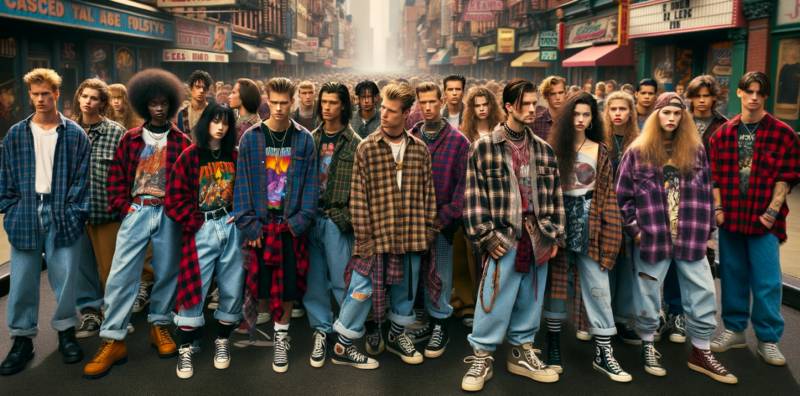Flannel Phenomenon: 1990s American Fashion Wave

Plaid, Plaid Everywhere
It was the roaring '90s, a decade of technological innovation, political upheaval, and most importantly, an era of fashion revolution. Grunge music was taking over the airwaves, and with it, an onslaught of plaid flannel emerged from the depths of our closets. The flannel phenomenon of the 1990s was a fashion movement that came to symbolize a generation, and has since remained a staple piece in the modern wardrobe.It all started with the bands of the Pacific Northwest, with names like Nirvana, Pearl Jam, and Soundgarden leading the charge. These musicians would take the stage clad in flannel, as if they had just emerged from a lumberjack's dream. It wasn't long before fans began to emulate their idols, and the streets of America became awash in a sea of plaid. It became a uniform of rebellion, a symbol of the burgeoning counterculture movement that was sweeping the nation.
The Unlikely Origins of Flannel
But where did this fascination with flannel originate? Believe it or not, the humble fabric has roots that stretch back to 17th-century Wales, where it was originally used to create warm, durable clothing for working-class laborers. The material was perfect for the damp, cold climate, and its unpretentious charm soon made it a staple in British fashion. Fast forward to the early 20th century, and the popularity of flannel had spread across the Atlantic, with American workers adopting the fabric for its practicality and comfort.It wasn't until the 1990s, however, that flannel went from workwear to fashion statement, thanks to the aforementioned grunge bands and their legions of loyal fans. Suddenly, the humble fabric was thrust into the spotlight, adorning the bodies of celebrities, models, and everyday folk alike.
Expanding the Flannel Empire
As the '90s progressed, so too did the ways in which flannel was incorporated into our wardrobes. No longer limited to the simple button-up shirt, flannel could be found in an array of garments, from trousers to skirts, and even to hats and accessories. The plaid print became a cultural touchstone, and designers began to incorporate it into their collections, adding their own unique twists to the classic fabric.One such innovator was Marc Jacobs, whose legendary collection for Perry Ellis in 1992 featured flannel aplenty, paired with high-fashion silhouettes and unconventional styling. The collection was met with mixed reviews, but it undeniably helped to cement flannel's place in the fashion world.
Practical Advice for the Flannel Aficionado
For those looking to incorporate flannel into their own sartorial repertoire, fear not - there are countless ways to embrace this versatile fabric. Here are a few tips to help you on your plaid-clad journey:- Focus on fit: A well-fitting flannel shirt should be neither too tight nor too loose, with enough room to move comfortably but not so much that you're swimming in fabric. Look for a shirt that hits just below the waist for a flattering silhouette.
- Experiment with color: While the traditional red and black buffalo plaid will always hold a special place in our hearts, don't be afraid to branch out into other color combinations. Try a more subdued palette for a sophisticated look, or make a statement with a bold, bright plaid.
- Play with texture: Don't limit yourself to just plain flannel - consider garments with interesting details like embroidery, appliqués, or even fringe for a fun twist on the classic fabric.
- Layer it up: Flannel shirts are perfect for layering over T-shirts, tanks, or even dresses, and can easily be tied around the waist for a casual, laid-back vibe. Pair with denim or leather for a tried-and-true combination that never goes out of style.
Flannel's Lasting Legacy
While the intensity of the flannel craze may have waned since the '90s, the fabric's influence on fashion remains undeniable. Today, you'd be hard-pressed to find a wardrobe that doesn't contain at least one plaid garment, and the popularity of this simple, unassuming fabric shows no signs of slowing down.From its humble beginnings as workwear for the masses, to its meteoric rise as a symbol of counterculture and rebellion, flannel stands as a testament to the power of fashion to unite, inspire, and endure. So, as you don your favorite plaid shirt and strut down the street, know that you're not just wearing a piece of clothing - you're wearing a piece of history.
Article kindly provided by foreverinfashion.org
Latest Articles
- Style That Works With Your Body, Not Against It
- Fashion Tourism on Wheels: Curated Shopping Routes Led by Chauffeur Guides
- The Charm of Certainty in a World of Indecision
- Can an Everyday T-Shirt Be Turned into a Modern Heirloom?
- Color, Ceremony, and the Psychology of Celebration
- Styling Graphic T-Shirts for Different Body Types
- Getting Kids to Wear Their Hats Without a Bribe or a Meltdown
- Mastering the Art of Being the Unnoticed Photographer
- Quiet Sportswear Moves Loudly
- Fashion's Most Misunderstood Color Is Brown
- Weight Matters When Cotton Gets Real
- SKU's Out for Summer: Why Your Warehouse Is Melting Down
- Ink as Accessory - How Tattoos Are Replacing Jewelry in Modern Style
- Decoding the Y2K Aesthetic with Style and Sanity
- Accessories
- Jewellery
- Footwear
- Skirts and Dresses
- Shirts and Blouses
- Beauty and Makeup
- Fashion Photography
- Sustainable Fashion
- Street Style
- Fashion History
- Fashion Business
- Fashion Styling
- Fashion Events
- Plus-Size Fashion
- Men's Fashion
- Women's Fashion
- Fashion Blogging
- Fashion Trends
- Fashion Retailers
- Fashion Tips and Advice
- Fashion Business Startups
- Fashion Around the World
- Lingerie
- Sportswear
- Weddings

